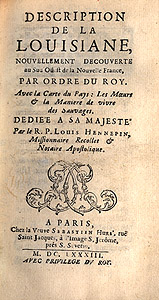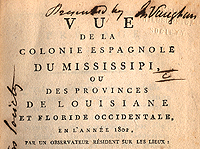One the richest biotic and cultural environments in North America, Louisiana reflects its connections with the Caribbean, Africa, Spain, France, Anglo-America, and Native America. From the late seventeenth century to its sale to the United States in 1803, Louisiana was viewed as one of the most troublesome gems of the French and Spanish empires, never quite attaining the level of profitability projected by its most ardent supporters
Throughout the eighteenth century, the meanings of Louisiana changed, just as its political jurisdiction and cultural mix changed. While not strictly works from the eighteenth century, and not strictly natural histories, the following four books reflect the themes of the
 |
| Title page of Hennepin's Description de la Louisiane |
A companion of the French explorer Robert Cavelier de LaSalle (1678-1680), the missionary and explorer Louis Hennepin suffers in posterity from the same ill reputation that he earned in life, though his
Description of Louisiana ensures his reputation will live on. His inflated sense of self and the duties of a promoter have, at times, been allowed to overshadow Hennepin's true accomplishments, but his book, a monument to himself, remains an important resource for understanding the mentality of early European explorers.
Born in Ath, Belgium, in 1626, Hennepin entered the Franciscan Récollet order in 1643 where he slowly acquired a taste for tales of adventure filtering in from across the sea. His opportunity to indulge this taste came in 1675, when he and four fellow priests were assigned to mission work in New France.
Having traveled to New France aboard the same ship as LaSalle, Hennepin arrived in Quebec City on June 16, 1675, and was soon delegated to accompany the explorer's westward expedition as historian. In the following spring, the expedition became the first Europeans to set sail on the Great Lakes and Hennepin became the first to describe Niagara Falls. Crossing Lakes Erie and Michigan, LaSalle settled at Baie des Puants (modern day Green Bay, Wisconsin),
By January, 1680, things were going sour for the expedition, running low on food and suffering the desertion of its members, and LaSalle decided to head back to Niagara. Hennepin and just two coureurs du bois were left to forge ahead. Heading down the Illinois River and then up the Mississippi, in April, 1680, he and his companions were captured by Indians and spirited away toward Lake Superior, locating the Falls of Saint Anthony above modern Minneapolis in the process and naming them after his patron saint. He was reclaimed by French authorities in September, and returned to France in the following year.
In 1697, Hennepin attached himself to the William and Mary, the English monarchs, and free from French interference, began hawking his own exploits at the expense of the assassinated LaSalle, claiming that he had traveled down the Mississippi to its mouth in the thirty odd days before being captured and that he could have done so twice had he had canoes. The dubious claim has been repeatedly shown to be unlikely or impossible, and Hennepin
 |
Cover of Italian translation of Hennepin
(click on image to see title page) |
Hennepin's
Description can rightly be called a promotional tract in two senses: promotional of the colony of Louisiana, and promotional of Hennepin himself. Missing no opportunity to tout his own courage and ingenuity in bisecting the North American continent, claiming to have been LaSalle's equal in leading the expedition and asserting that it was he who had actually discovered the source of the Mississippi River.
Whatever its inaccuracies or exaggerations, the Description was wildly influential from the moment of its first publication in 1683. It was translated into Italian in 1686 (a very rare work), Dutch in 1688, and had passed through two editions in English by 1698.
 |
| Title page of Berquin's Vue de la Colonie |
When Louisiana passed from Spanish to French to Jeffersonian hands in 1803, there was a renewed tri-national spark of interest in the colony. Languishing under French and Spanish hands alike, the colony had never achieved the profitability predicted for it, and the little-known author Berquin-Duvallon painted a less than attractive picture of the place. Providing a general survey of climate, soil, the city of New Orleans, slavery, and creole culture, and with an important description of sugar culture and production, Berquin Duvallon recoiled in horror at the effects of the Revolution in Saint Domingue (Haiti) and the treatment of refugees in U.S. and Louisiana.
Berquin Duvallon is also notably drawn deeply into the racialized thought characteristic of the 19th century. Convinced that the "independent spirit" of American Indians made it impossible to enslave them, he wrote "It is not the same with Negroes, and for them slavery is, as it is in the countries in which they originate as elsewhere, a natural state from which they leave only with violence, and into which, on the contrary, they enter with ease, like a flock of sheep entering the stable."
 |
| Title page of Baudry de Loziere's Voyage |
The
Voyage à la Louisiane is one of several French works on the history and natural history of Louisiana written during the excitement following its (temporary) return to French jurisdiction in 1803. Baudry de Lozière's lengthy discussions of the Indians of Louisiana -- including vocabularies of "Sioux" and Chippewa languages - his detailing of climate, cultivation, plants, insects, birds, and fish set the natural firmly into political history.
In excusing himself from providing a detailed listing of insects, Baudry wrote "The genera are so numerous and the species so varied that one would need to write an encyclopedia, and that is not my object: all I can say is that in this country, 'insectologists' will find themselves employed for many years on this one subject."
Nous allons rentrer en possession de la Louisiane, et chacun raisonne sur cet objet suivant son intérêt personnel ou d' après les renseignemens, souvent incertains, qu' il s' est procurés. Quand nous avons cédé ces belles régions aux espagnols, nous leur avons remis aussi tout ce que nous avions d' instruction sur elle ; ensorte qu' aujourd' hui il ne nous en reste que des idées imparfaites, et depuis 1769 nous n' y avons songé que faiblement, parce que nous n' avions plus d' intérêt à y porter une sérieuse attention. Nous avons quelques ouvrages anciens, faits, il est vrai, par des personnes qui ont vu ; mais ce ne sont que de faibles abrégés, et je crois donner une histoire aussi complète qu' il est possible de le faire pour le présent. Je me suis appliqué à ce qu' on n' avait point fait encore, à familiariser le lecteur avec le caractère des sauvages, à reposer son esprit sur les productions de ce beau pays, à fixer son attention sur les différentes parties du commerce, et à donner des moyens de rendre la navigation plus sûre. Ce n' est point ici une compilation, c' est le résultat des notes que j' ai prises sur le continent même ; et si la sévère défiance des espagnols en 1795 et années suivantes, ne m' a pas permis de compléter mon voyage, j' ai été si près des objets que je puis dire les avoir tous vus.




